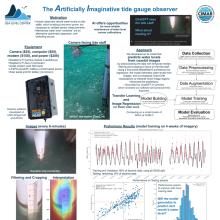The artificially imaginative tide gauge observer
Matthew
Widlansky
University of Hawaii
Poster
Tide gauges are the link between observing sea levels in the ocean and water levels along the coast, which are increasingly impacting society. Ensuring the utility and robustness of these coastal observations involves overcoming challenges related to effectively communicating information and minimizing measurement uncertainty. Traditionally, scientists assist with communicating understanding about the observations and trained local observers play a role validating measurements. However, these manual (human) processes can be tedious and prone to errors. We are exploring opportunities and challenges posed by the rapidly advancing field of artificial intelligence, which we refer to here as Artificially Imaginative (AI) technology because of its seeming ability to generate information from data. Three AI applications related to tide gauge observations are being developed at the University of Hawaii Sea Level Center. We will introduce the Tidal Datums Helper, which is an application that utilizes large-language model technology to answer user questions about water level references for the measurements. Another research activity is to utilize camera imagery to validate the calibration of water level sensors, such as by automatically observing water levels on a tide staff. The third application we are researching is using prediction approaches for quality control and assurance of tide gauge observations, such as by configuring Long-Short Term Memory (LSTM) models to identify unrealistic measurements. The key challenge remains assessing whether these technologies provide improvements compared to traditional methods used by scientists, observers, and communicators to inform about coastal sea level conditions.

Poster file
widlansky-matthew-optimizing-poster.pdf
(5.83 MB)
